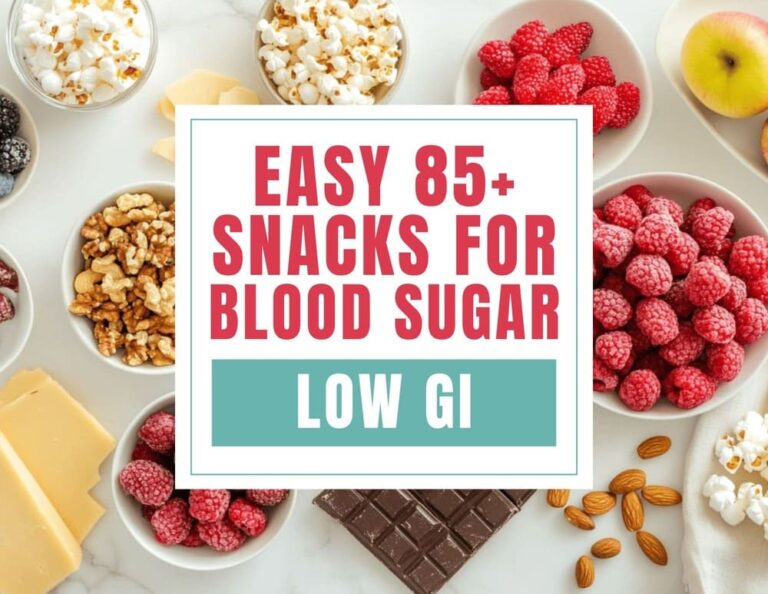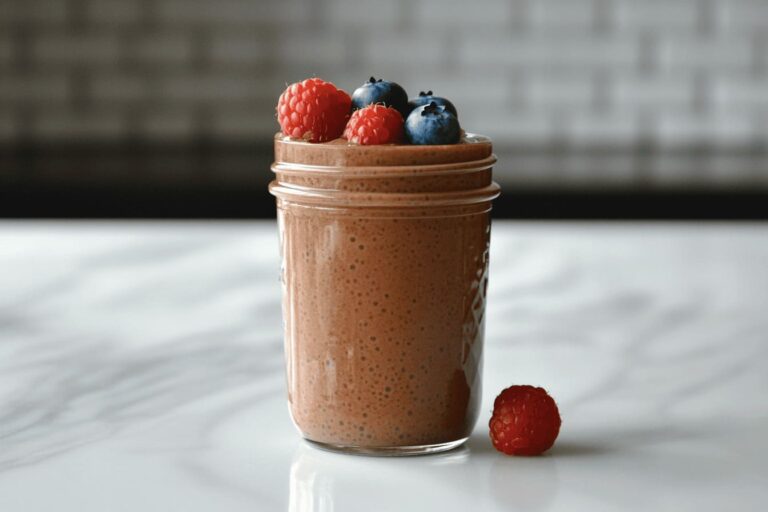[FREE PRINTABLE] Low Glycemic Index Food List PDF
This post may contain affiliate links. That means if you click and buy, I may receive a small commission (at zero cost to you). Please see my full disclosure policy for more details.
The Low Glycemic Index Food List PDF is here! And it’s completely free for you to use.

If you have elevated blood sugar, understanding the Glycemic Index (GI) becomes very crucial.
When I first got my prediabetes and gestational diabetes diagnosis, I thought I had the glycemic index all figured out—after all, I’m a pharmacist, right?
But managing my own blood sugar turned out to be a real EYE-OPENER.
I made some classic mistakes that I’m a little embarrassed to admit.
Like the time I proudly swapped white bread for whole wheat, thinking I was making a smart, low-GI choice. Not all whole wheat bread is created equal, and some are so processed that they send your blood sugar soaring.
And oh, my beloved morning fruit smoothies. I thought I was doing something good by blending up bananas and berries, but it turns out that blending destroys the fiber that slows down sugar absorption.
In this post, I’m sharing these lessons with you so you can avoid the same GI pitfalls.
What is the Glycemic Index?
The glycemic index is like a SCORECARD for foods, showing how quickly and significantly a food will spike your blood sugar.
Think of it as your blood sugar’s personal speedometer.
It’s a scale from 0 to 100.
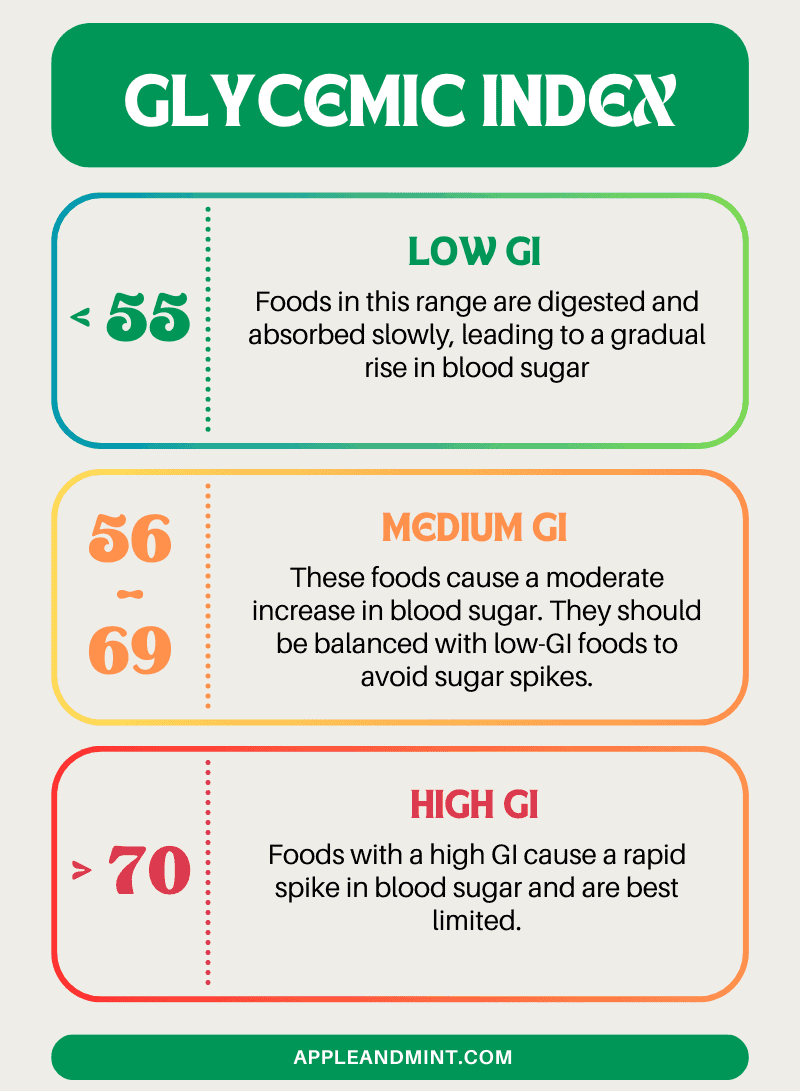
What is a Healthy Glycemic Index?
A healthy glycemic index is typically considered to be in the LOW to MODERATE range.
Which GI is Good for Diabetics?
For anyone with high blood sugar, sticking to LOW GLYCEMIC INDEX foods is key.
We’re talking about those foods with a GI of 55 or less—the ones that keep your blood sugar on a steady, smooth ride instead of a rollercoaster.
For me personally, I try to keep my meals at 70-80% low-moderate GI foods at least.
Importance of Low Glycemic Index for Diabetics / Prediabetics:
- Steady Blood Sugar:
- Low-GI foods release glucose into your bloodstream slowly, helping to keep those blood sugar level nice and stable.
- Less Insulin Needed:
- By skipping the high-GI foods, you’re also cutting down on how much insulin your body needs to produce, making life a bit easier for your pancreas.
- Keeps You Full:
- Low-GI foods are also great for keeping you satisfied longer, which is a big win when it comes to managing your weight.
Medium-GI foods (56-69) can be included in moderation, but high-GI foods (70 and above) should be on your “limit” list if you want to keep your blood sugar in check.
Check out the Low Glycemic Index Food List PDF.
Factors Affecting the Glycemic Index of Foods
When I finally got my hands on my glycemic index (GI) food list, I was convinced my blood sugar would be perfectly controlled.
But that’s only half the story.
The other half? It’s about the other factors that influence the GI:
- Type of Carbohydrate
- Simple carbs, like sugary treats, hit your bloodstream fast, giving you a quick spike in blood sugar.
- Complex carbs, like whole grains, digest more slowly and keep things steady.
- Food Preparation and Cooking Method
- Cooking Time: Overcooking pasta? Expect a higher GI. Cook it al dente, and you’ll keep that GI in check.
- Processing: The more processed your food, the higher its GI. Go for whole, unprocessed foods.
- Fiber Content
- Fiber slows down the digestion of carbs, keeping your blood sugar levels steady.
- So, load up on fiber-rich foods like veggies, fruits, and legumes.
- Ripeness of Fruit
- The ripeness of your fruit affects its GI.
- Ripe bananas have a higher GI of 60, while less ripe ones (GI 30-40) are easier on your blood sugar.
- Fat and Protein Content
- Adding fats or proteins to your meal can slow down carb digestion.
- So, mix in some nuts or lean protein.
- Food Combinations
- Pair high-GI foods with low-GI options to balance things out.
- Toss some beans into your salad or enjoy fruit with a handful of nuts.
- Food Structure
- Whole foods are your best friends.
- Whole grains and whole fruits generally have lower GIs compared to their processed or juiced counterparts.
- Acidity
- Adding a splash of vinegar or lemon juice can help lower the GI of your meal.
It’s Not Just About Carbs.
While carbs are the primary factor influencing GI, other factors like cooking methods, ripeness, and even the variety of the same food can affect its GI.
Glycemic Index Chart: At a Glance
I used to spend ages searching Google for the most detailed, complete glycemic index food list to stick on my fridge, but none of them were quite right.
So, I decided to take things into my own hands, did the research, and created this ultimate list of 400+ foods for myself and you.
You deserve only the best, so here it is!
Vegetables

Fruits
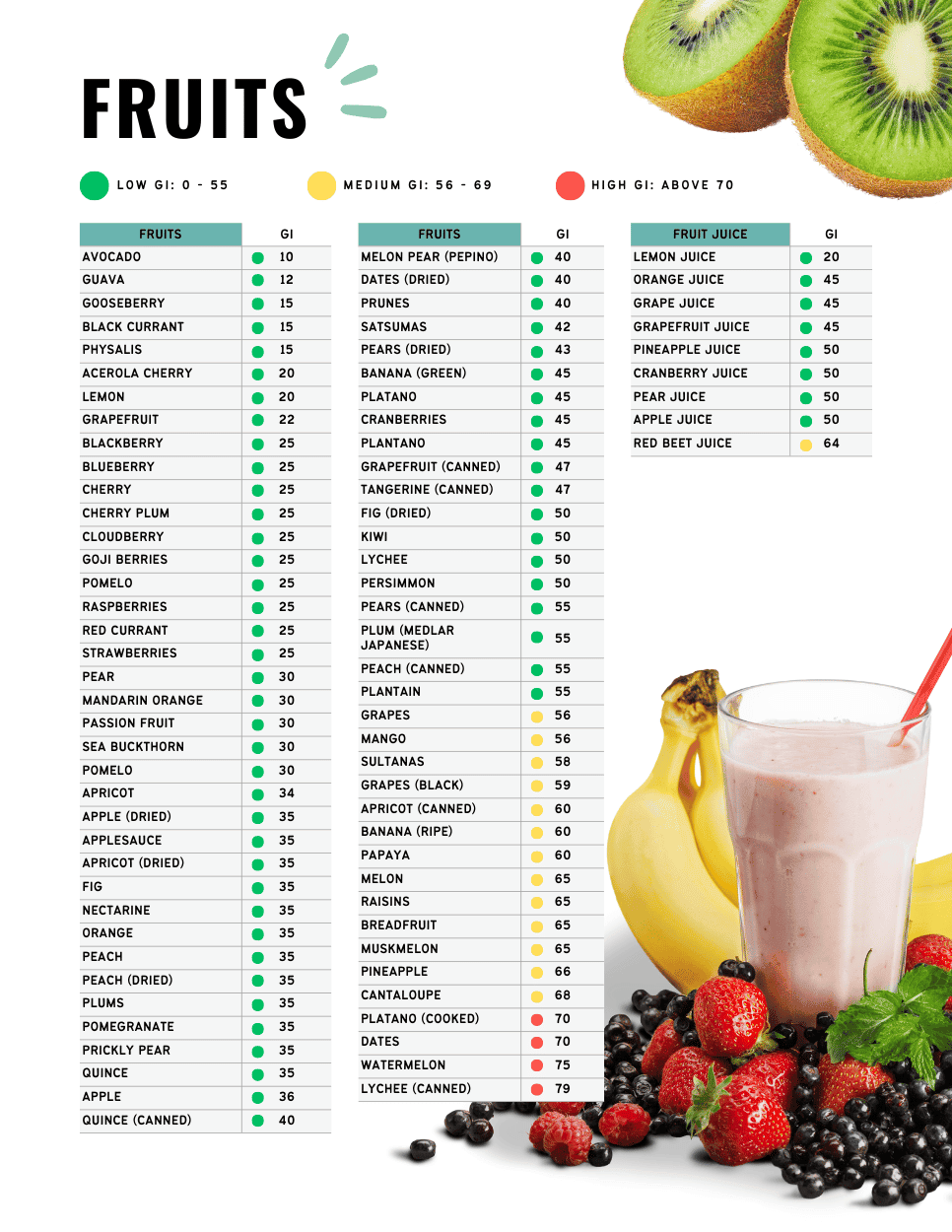
Grains

Check out more details on different lower GI alternatives to white rice.
Protein & Dairy
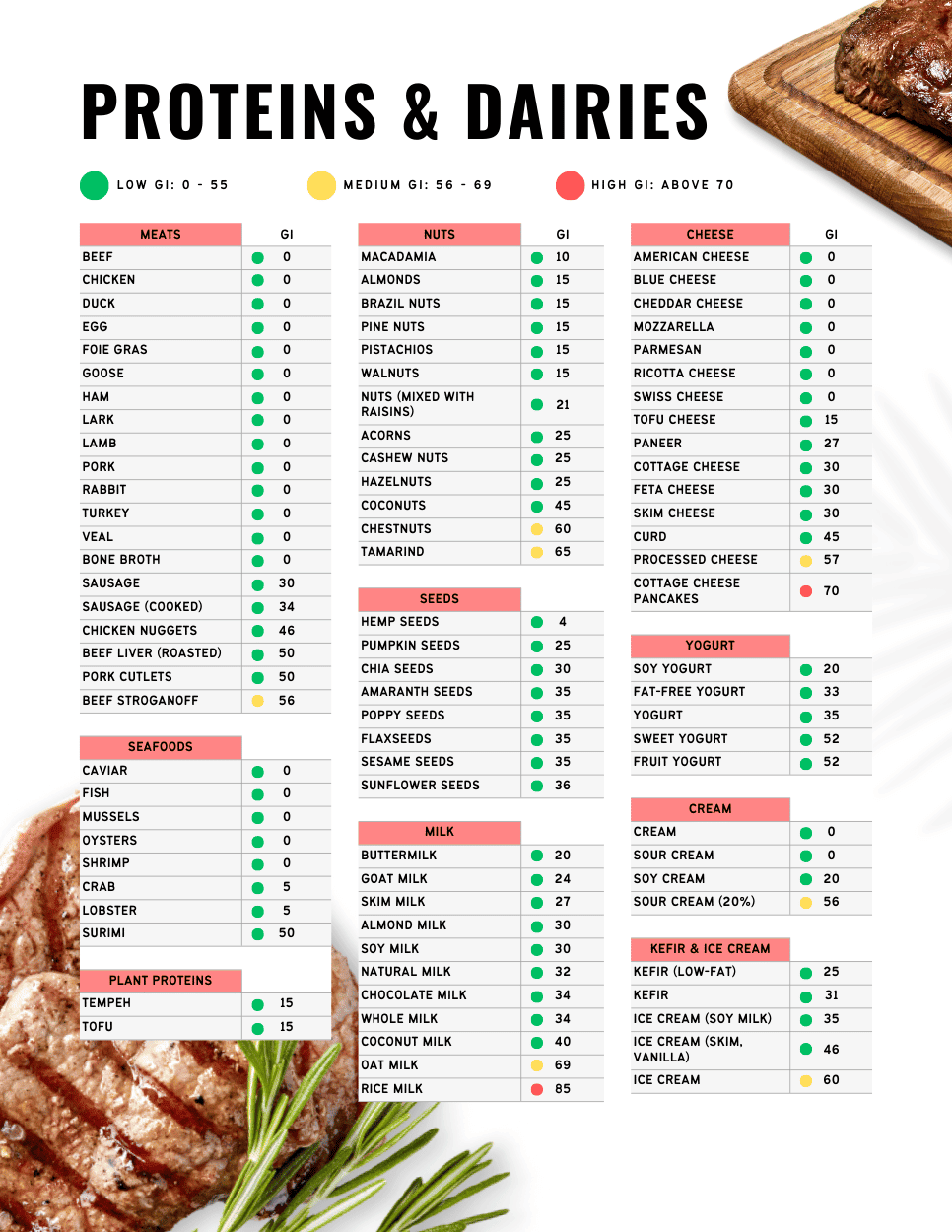
Lovin’ the comprehensive GI list on these 400 foods?
But that’s just the beginning!
I’ve also curated a more extensive GI list featuring over 650+ foods, packed with the same detailed insights. You’ll get additional info on:
- Fats and oils
- Herbs and spices
- Condiments
- Snacks and desserts
- Soups
- Beverages
- And so much more!
Don’t miss out!
Get your hands on my FREE Complete Low Glycemic Index Food List PDF here.
What are the Best Low GI Foods?
Whole Grains
Barley, Quinoa, and Rolled Oats:
- Fiber Power: These whole grains are fiber-rich, which means they keep your blood sugar steady and your tummy satisfied.
- Nutrient Boost: They pack essential vitamins and minerals that support energy and overall wellness.
- Feel Fuller Longer: Their fiber content helps you stay full and energized throughout the day.

You can read more about different whole grain alternatives to white rice here.
Legumes
Lentils, Chickpeas, and Black Beans:
- Protein & Fiber Combo: They’re loaded with protein and fiber to keep your blood sugar in check and hunger at bay.
- Slow Digestion: Their low GI means they offer a steady rise in blood sugar, perfect for balanced energy.
- Nutrient-Rich: Packed with iron and folate, they support your overall health and vitality.
Fruits
Apples, Oranges, and Berries:
- Natural Sweetness: These fruits satisfy your sweet tooth without the sugar spike, thanks to their fiber content.
- Vitamin Boost: They’re loaded with vitamins and antioxidants to boost your immune system and reduce inflammation.
- Versatile Snacks: Enjoy them fresh, in smoothies, or as a topping for a nutrient-packed boost.
Non-Starchy Vegetables
Spinach, Broccoli, and Cauliflower:
- Low-Carb Goodness: These veggies are low in carbs and calories but high in nutrients and antioxidants.
- Health Powerhouse: They’re rich in vitamins and minerals that support everything from bone health to immune function.
- Versatile Choices: Add them to salads, stir-fries, or as a side dish to maximize your nutrition.
Dairy and Alternatives
Plain Yogurt, Almond Milk, and Soy Milk:
- Protein & Nutrients: They provide essential protein and calcium while keeping your glycemic index low.
- Gut Health: Yogurt’s probiotics help maintain a healthy gut, which supports overall well-being.
- Delicious Options: Choose unsweetened varieties to enjoy the benefits without the added sugars.

Nuts and Seeds
Almonds, Chia Seeds, and Flaxseeds:
- Healthy Fats & Fiber: These snacks are rich in healthy fats and fiber, keeping your blood sugar stable and hunger at bay.
- Nutrient-Packed: They’re loaded with omega-3s, vitamins, and antioxidants for a health boost.
- Snack Smart: Add them to your meals or enjoy as a snack for a crunchy, nutritious boost.

What are High Glycemic Foods to Avoid?
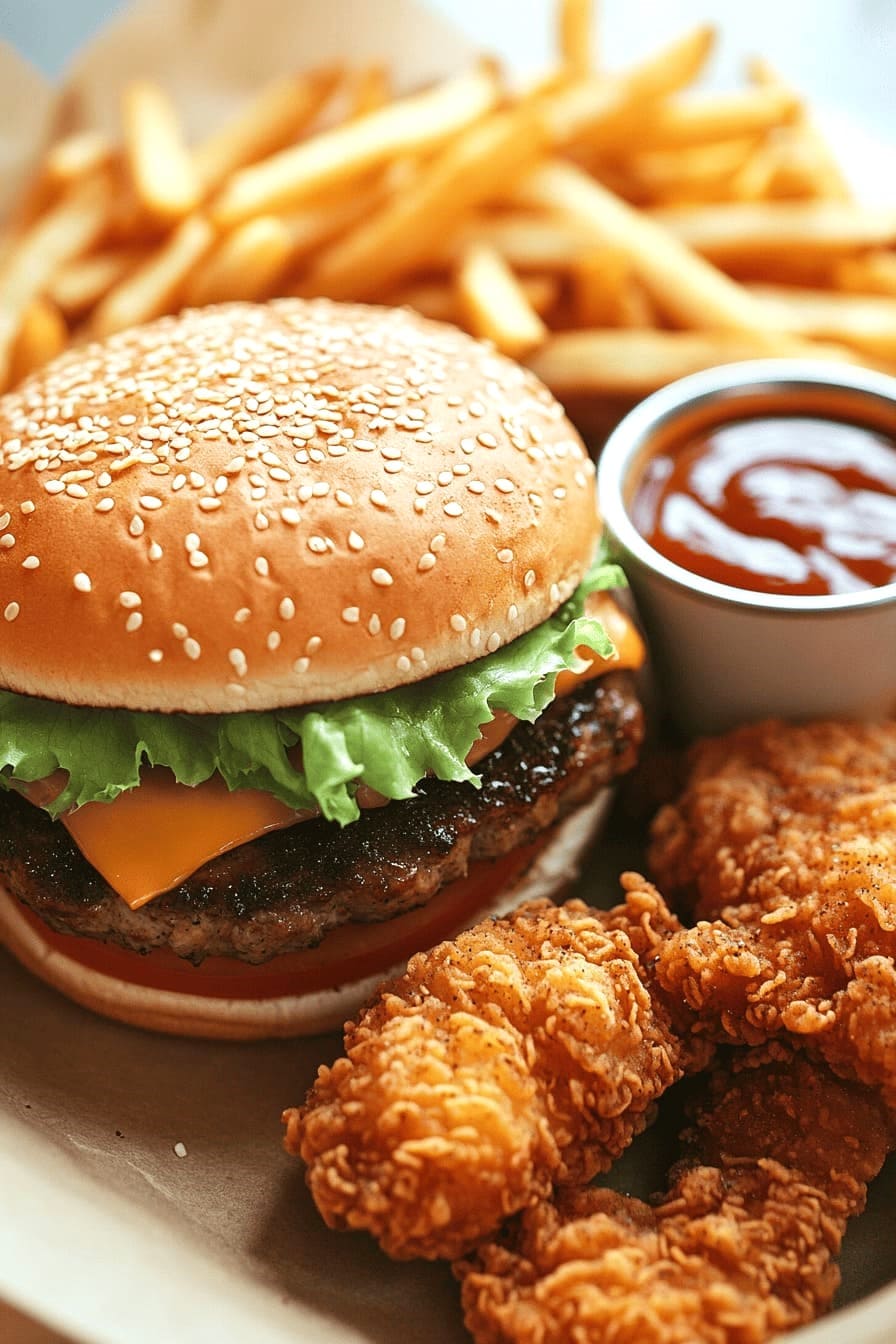
Refined Carbohydrates
White Bread, Pastries, and Crackers:
- Quick Sugar Surge: These foods cause a rapid spike in blood sugar, leading to energy crashes and cravings.
- Low Nutrient Value: They lack essential nutrients and fiber, offering empty calories that don’t support your health goals.
Sugary Beverages
Soda, Fruit Juices, and Energy Drinks:
- Quick Sugar Surge: These foods cause a rapid spike in blood sugar, leading to energy crashes and cravings.
- Low Nutrient Value: They lack essential nutrients and fiber, offering empty calories that don’t support your health goals.
Processed Snack Foods
Chips, Candy Bars, and Cookies:
- Blood Sugar Rollercoaster: These are loaded with refined sugars and unhealthy fats that cause quick sugar spikes.
- Nutrient Deficient: They offer little nutritional value and can lead to overconsumption due to their addictive nature.
Certain Breakfast Cereals
Sugary Cereals and Instant Oatmeal:
- Fast Blood Sugar Rise: High in sugar and refined carbs, they cause your blood sugar to surge right after you eat.
- Low Fiber: They’re often low in fiber, so they don’t help in maintaining stable blood sugar levels.
White Rice and Pasta
Plain White Rice and Regular Pasta:
- High Glycemic Impact: These foods can cause a rapid rise in blood sugar, similar to other high-GI foods.
- Less Nutritional Value: They’re stripped of their nutrients and fiber, which are essential for balanced blood sugar.
Baked Goods
Cakes, Muffins, and Donuts:
- Sugar & Fat Loaded: These items are high in sugars and fats, causing rapid blood sugar spikes and crashes.
- Empty Calories: They provide few essential nutrients and are often made with refined flours and sugars.
Check out the Printable Low Glycemic Index Food List PDF here.
Practical Tips for Using the Glycemic Index
- Opt for Low-GI Foods
- Stick to foods with a GI of 55 or less—think whole grains, legumes, and non-starchy veggies.
- Combine Foods
- Pair those high-GI foods with low-GI options to keep things balanced.
- Enjoy a juicy apple with a handful of almonds, or toss some beans into your salad.
- Watch Portion Sizes
- Even the healthiest foods can impact your blood sugar if you go overboard.
- Keep an eye on portion sizes to stay in control.
- Choose Whole Foods Over Processed
- Opt for fresh fruits, veggies, and whole grains over processed snacks.
- Whole foods are not only lower in GI but also packed with nutrients.
- Focus on Fiber
- Fiber is your best friend for slowing down carb digestion and lowering GI.
- Fill up on fiber-rich foods like vegetables, fruits, and legumes.
- Prepare Meals Wisely
- How you cook your food affects its GI.
- For example, cooking pasta al dente keeps its GI lower than if it’s overcooked.
- Read Labels and Research
- Check out the GI of foods you’re curious about and read those nutrition labels. Go for lower total carbohydrate and sugar content.
- Choose options with less sugar (especially <5g of added sugar, as recommended by American Heart Association (AHA)), and avoid those with artificial sweeteners if possible.
- Try Carb Sequencing
- Start with proteins or non-starchy veggies before diving into carbs. This trick helps slow the absorption of sugars from high-GI foods.
- Study shows that this can reduce spike by up to 30%.
- For example, start with a salad and nut starter before taking the mashed potato for dinner.
Pro Tips: What If I Crave High-GI Foods?
Having diabetes or prediabetes doesn’t mean you have to completely avoid high-GI foods. Here’s what you can do:
- Pair them with protein, fiber, or healthy fats to lower the overall GI. For examples,
- French fries: Enjoy with grilled chicken breast and a side salad. Or substitute it with zucchini fries.
- Ice cream: Pair with a handful of walnuts.
- Cakes: Pair a small slice with a handful of unsalted nuts.
- White rice: Combine with grilled chicken and steamed broccoli.
- Potato Chips: Choose baked or air-fried chips. Enjoy a small serving with guacamole or hummus.
- Eat fiber first, then protein or fat, and finish with carbs.
- A 20-minute brisk walk afterward can also help reduce sugar spike by up to 20%.
Limitation of the Glycemic Index
When I first delved into managing my blood sugar, I was all about choosing low-GI fruits.

Berries were my go-to—I’d enjoy up to 2 CUPS a day, thinking I was making the perfect choice for stable blood sugar levels.
But even though berries have a low Glycemic Index (below 40), consuming them in large portions can still lead to a spike in blood sugar.
This experience taught me that while focusing on low-GI foods is essential, it’s not a complete solution:
- Individual Variability
- What keeps one person’s blood sugar stable might not have the same effect on another.
- Eg, oatmeal stabilizes blood sugar for some but may cause spikes in others.
- Does Not Reflect Portion Size
- GI measures the effect of a standard amount of food, but in reality, we often eat larger portions.
- Even low-GI foods like berries can impact your blood sugar in large quantities.
- Nutritional Quality
- GI doesn’t reflect the overall nutritional quality of foods.
- A low-GI food (such as sweetened dark chocolate) can still be high in sugar or fats, while a high-GI food (like watermelon, dates, or potatoes) can be rich in essential nutrients.
- Meal Context
- GI doesn’t account for how foods interact with each other.
- Combining low-GI foods with high-GI foods can change the overall blood sugar response of your meal.
- Does Not Measure Long-Term Effects
- GI focuses on the short-term blood sugar response.
- Long-term health outcomes and overall diet quality are just as important.
- Varied GI Values
- The GI of foods can vary based on factors like ripeness, preparation, cooking, and brand differences, making it tricky to rely solely on GI.
Now that you know blood sugar spikes are complex and multifactorial, how do you prevent them?
- Check your blood sugar after eating—you’ll learn what works best for your body over time.
- Talk to your dietitian to find the best personalized plan for you!
Glycemic Index vs Glycemic Load: What’s the Difference?
When managing blood sugar, you might come across both Glycemic Index (GI) and Glycemic Load (GL).
While they’re related, they offer different insights into how foods affect your blood sugar.
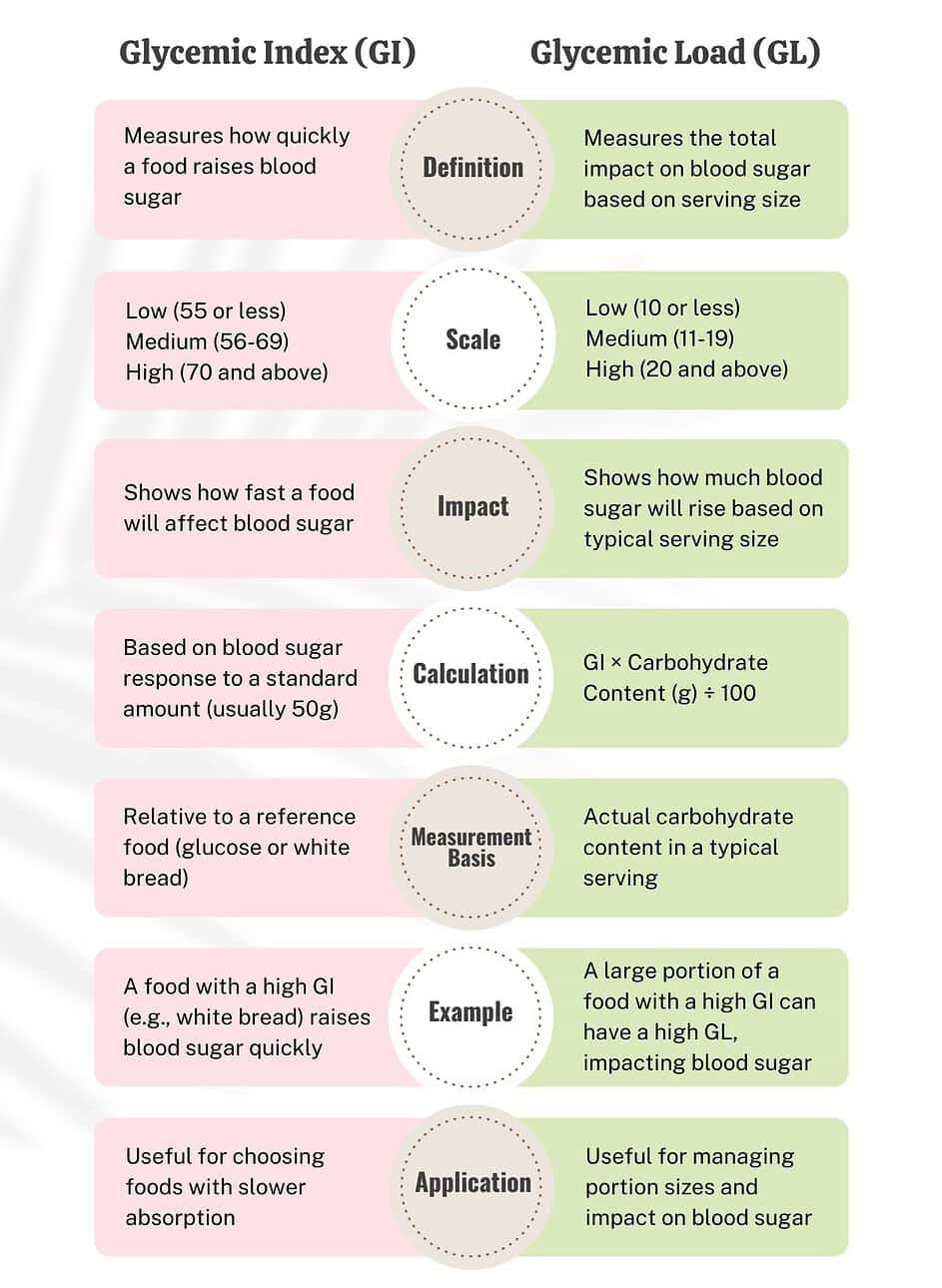
Did you know that some foods are HIGH in Glycemic Index but have a LOW Glycemic Load when consumed in small amount?
Honey, dried fruits, and cornflakes are great examples.
Glycemic Load Matters More:
The glycemic load takes into account both the GI and the serving size of a food. A food with a high GI but a small serving size might have a low GL, making it less likely to spike blood sugar.
Conclusion
Remember, low-GI foods like berries, whole grains, and legumes are fantastic for maintaining steady blood sugar levels, while high-GI foods should be enjoyed in moderation.
In my personal journey, I spent a year practicing and learning about GI.
Initially, I found it challenging, but over time, I became familiar with the patterns and could manage my diet without constantly referring to a GI chart.
Insulin resistance may be part of your life now, but it doesn’t have to control you.
I started to see the process as a fun and rewarding discovery about my body rather than a source of anxiety. It became a fun and insightful journey.
I went from thinking, “Oh shit, my sugar spiked again!” to saying, “Ah, interesting—so this yogurt isn’t suitable for me.”
It’s time to take control of your health and make informed choices with confidence.
Download: Low Glycemic Index Foods List PDF
To help you on your path, I’ve prepared a print-friendly version of the Low Glycemic Index Food List PDF, with additional 250+ more foods vs what you have seen here.
This printable is perfect for easy reference and can be pasted on your fridge for quick access.
To get your hands on this helpful Glycemic Index Food Chart PDF, simply check out the box below.





